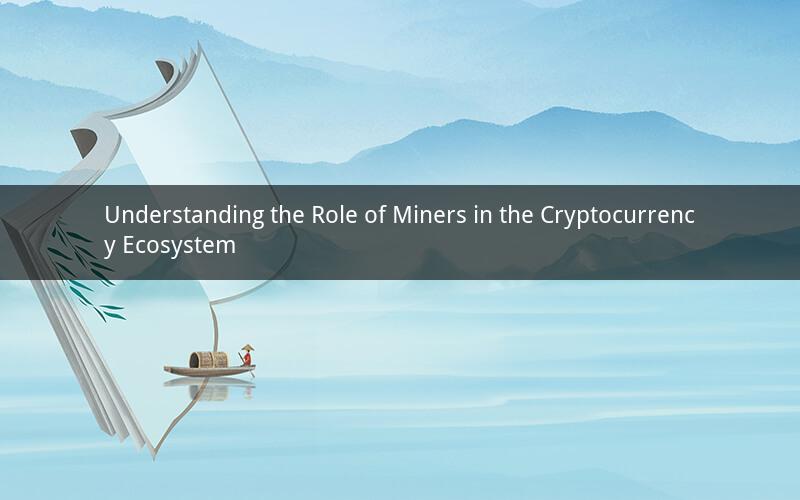
In the world of digital currencies, miners play a crucial role in maintaining the integrity and security of the blockchain network. But what exactly is a miner, and how do they contribute to the cryptocurrency ecosystem? This article delves into the essence of cryptocurrency mining, its significance, and the process involved.
What is a Miner in Cryptocurrency?
A miner in the context of cryptocurrency is an individual or entity responsible for validating and adding new transactions to a blockchain. Miners use powerful computers to solve complex mathematical problems, which helps secure the network and ensure the accuracy of transaction records. In return for their efforts, miners are rewarded with cryptocurrency tokens, typically the native currency of the blockchain they are mining on.
The Significance of Miners in the Cryptocurrency Ecosystem
1. Security: Miners play a vital role in ensuring the security of the blockchain network. By solving complex mathematical problems, they prevent malicious actors from manipulating the data on the blockchain. This process is known as Proof of Work (PoW), and it requires a significant amount of computational power, making it difficult for hackers to compromise the network.
2. Transaction Validation: Miners validate and confirm transactions on the blockchain. This ensures that the records are accurate and reliable. By adding new blocks to the blockchain, miners help maintain the chronological order of transactions and prevent double-spending.
3. Consensus: Miners contribute to the consensus mechanism of the cryptocurrency network. In PoW-based cryptocurrencies, miners compete to solve mathematical puzzles, and the first to find a solution adds a new block to the blockchain. This process helps establish a consensus on the validity of transactions and the state of the network.
4. Decentralization: Miners promote decentralization by ensuring that no single entity has control over the network. Since anyone can become a miner, the process of validating transactions is distributed across various participants, making the network more resilient to attacks.
The Cryptocurrency Mining Process
1. Setting Up a Mining Rig: To become a miner, one needs to set up a mining rig, which is a specialized computer designed for mining. The rig consists of a high-performance graphics processing unit (GPU), a solid-state drive (SSD), and a reliable power supply.
2. Joining a Mining Pool: Mining solo can be challenging, as the chances of solving a mathematical puzzle and earning a reward are relatively low. Many miners opt to join a mining pool, which is a group of miners working together to increase their chances of finding a solution. When a block is solved, the rewards are distributed among the pool members based on their contribution.
3. Running the Mining Software: Miners need to install mining software on their rigs, which connects them to the blockchain network and allows them to participate in the mining process. The software communicates with the mining pool and sends the necessary data to the miner's GPU for processing.
4. Solving Mathematical Puzzles: Miners use their GPUs to solve complex mathematical puzzles. These puzzles are designed to be computationally intensive, requiring a significant amount of time and resources to solve. The first miner to solve the puzzle is rewarded with cryptocurrency tokens.
5. Verifying and Adding Transactions: Once a puzzle is solved, the miner's software verifies the new block of transactions and adds it to the blockchain. This process ensures that the transactions are secure and accurate.
Common Challenges in Cryptocurrency Mining
1. High Costs: Mining requires a significant amount of electricity and hardware, which can be expensive. As the difficulty of solving mathematical puzzles increases, the costs associated with mining also rise.
2. Market Volatility: The value of cryptocurrencies can be highly volatile, which can affect the profitability of mining operations. When the price of a cryptocurrency falls, mining operations may become unprofitable.
3. Environmental Concerns: Cryptocurrency mining consumes a considerable amount of electricity, which can lead to environmental issues. Some countries have implemented regulations to limit the amount of energy used for mining.
Frequently Asked Questions
1. What is the purpose of mining in cryptocurrency?
Mining ensures the security, transaction validation, and decentralization of the blockchain network.
2. How do miners earn cryptocurrency?
Miners are rewarded with cryptocurrency tokens for solving mathematical puzzles and adding new blocks to the blockchain.
3. What is a mining pool, and why do miners join them?
A mining pool is a group of miners working together to increase their chances of finding a solution. Joining a pool allows miners to earn rewards more consistently.
4. What are the environmental concerns related to cryptocurrency mining?
Cryptocurrency mining consumes a significant amount of electricity, which can lead to environmental issues such as increased greenhouse gas emissions.
5. How can I become a miner?
To become a miner, you need to set up a mining rig, join a mining pool, and install mining software on your computer. Ensure that you have a reliable power supply and consider the costs associated with running a mining operation.